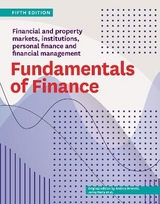
Fundamentals of Finance
Massey University Press (Verlag)
978-0-9941325-2-9 (ISBN)
- Titel erscheint in neuer Auflage
- Artikel merken
This fourth revised and updated edition gives a practical overview of contemporary finance from a New Zealand perspective. It helps students understand: * How the financial system and the institutions within it operate. * How and why financial decisions are made. * The tools, techniques and concepts used in finance, and how they are applied to the major sectors of finance. * How individuals plan their short- and long-term financial activities. * How business organisations manage and finance their short- and long-term financial activities. Broad in scope, Fundamentals of Finance explains the important financial decisions made by businesses and individuals, and how these decisions are influenced by the financial environment in which we live and work. It provides an introduction to finance that assists students to make their own financial decisions. Helpful features include: examples, self-test questions (with solutions!), learning objectives, a glossary of terms and useful formulae.
Andrea Bennett is a senior tutor in Masseys School of Business and her research focuses on financial systems, investments and financial planning, and financial literacy. Jenny Parry is a former senior lecturer in the Department of Finance, Banking and Property at Massey University, and is now a self-employed consultant. Carolyn Wirth holds a PhD in Finance from Massey University and her current research investigates the corporate financial implications of country-level environmental regulatory stringency.
Preface ix
PART 1: FINANCIAL SYSTEMS Chapter 1: An overview of finance Introduction 3 Definition of finance 4 The financial system Finance as a discipline for study 5 The interdisciplinary nature of finance Finance and business 7 The business environment and stakeholder protection * The four levels of financial decision-making * Personal level * Sole proprietorship level * Partnership level * Corporation level The ethics dilemma 13 Agency problems * Conflict of interest Financial markets 13 The existence of private wealth * Freedom of choice * Incentives * Efficient markets * The role of government Careers in finance 16 Conclusion 18 Self-test question and answer 19 Questions and problems 19
Chapter 2: Financial markets Introduction 20 Financial assets 20 Debt versus equity claims * Prices of financial assets * The roles of financial assets Financial markets 22 The roles of financial markets * Market participants * Types of financial market Money markets 25 Market operation and participants * Types of instruments traded Capital markets 26 The debt markets * The equities market Foreign exchange (FX) market 29 Market operations and participants * Types of instruments traded
Derivative markets 30 Types of derivative instruments * The operation of the market * Participants in the futures market * Forward contracts * Options contracts * Participants in the options market Conclusion 36 Self-test questions and answers 37 Questions and problems 37
Chapter 3: Financial institutions Introduction 38 The development of the modern financial system 38 The modern role of government in the financial intermediation process * Regulations to control the soundness of the financial system Credit creation 43 Credit multiplier Monetary policy - three control mechanisms 44 The official cash rate * The inflation problem Modern financial intermediaries 47 Depository institutions * Non-depository institutions * The benefits of financial intermediation Ethics and financial institutions 51 Classifying types of financial transfers 51 Conclusion 52 Self-test questions and answers 53 Questions and problems 53
PART 2: FINANCE TOOLS Chapter 4: Time value of money - Single payments Introduction 55 Simple interest and future value 56 Simple interest and calculating the present value 58 Compound interest and future value 58 Other methods of calculation * The present value of a single payment * Compounding frequency * Continuous compounding/discounting Nominal and effective interest rates 70 Solving for an unknown interest rate 72 Solving for an unknown time period 73 Conclusion 75 Self-test questions and answers 75 Questions and problems 77
Chapter 5: Time value of money - Multiple payments Introduction 79 Multiple cash flows 79 Future value of multiple cash flows * Present value of multiple cash flows Level cash flows: Annuities and perpetuities 82
Future value of an annuity * Present value and annuities Finding the amount of a regular payment 88 Annuity due 90 Perpetuities 92 Asset valuation: Calculating the price of a bond 93 Loan types 97 Conclusion 99 Self-test questions and answers 100 Questions and problems 100
PART 3: PERSONAL FINANCE Chapter 6: Risk and return Introduction 104 Risk-free assets 105 The two components of a return * Nominal interest rate Term structure of interest rates 107 Shape of yield curves Risky assets 109 Risk and return - the trade-off 111 Measuring historical risk and return 113 Returns from investment * Holding period returns and yields * Standard deviation as a measure of risk Measuring future risk and return 119 The benefit of diversification 121 The capital asset pricing model and the security market line relationship 125 Conclusion 127 Self-test questions and answers 128 Questions and problems 135
Chapter 7: Personal financial management Introduction 136 The personal financial planning activity 136 Money management 138 Gathering financial information * Preparing an income statement * Budget preparation * Developing a personal balance sheet Financial planning for life 141 Financial goal attainment 143 Funding a retirement plan 144 Retirement income gap * KiwiSaver * Choosing a KiwiSaver fund Residential property and mortgages 149 Criteria for choosing residential property * Financing the purchase of residential property Starting or buying a business 153 Personality traits * Preliminary evaluation * Business plan Conclusion 163 Self-test question and answer 164 Questions and problems 167
PART 4: FINANCIAL MANAGEMENT Chapter 8: Financial management Introduction 169 Role of financial management 170 Financial management * Organisational context Objective of financial management 172 What about profit maximisation? * Time value of money * Cash flows * Risk * Managers as agents * Economic implications of wealth maximisation The external environment 179 Financial markets * Regulatory environment Risk and return 180 Conclusion 183 Self-test questions and answers 184 Questions and problems 185
Chapter 9: Investment in net working capital Introduction 189 Net working capital 189 Risk-profitability trade-off 190 Management of net working capital 190 Managing cash 191 Cash and near-cash * Motives for holding cash * Forecast cash flow statement Management of accounts receivable 194 Setting credit policy Management of inventory 195 Economic order quantity model * Computerised inventory control system * Just-in-time system Management of current liabilities 196 Cash conversion cycle 201 Conclusion 203 Self-test questions and answers 204 Questions and problems 206
Chapter 10: Financing the firm Introduction 212 Features of debt and equity 212 Funding a firm's life cycle 213 Start-up stage * Growth stage * Maturity stage Choosing the financing mix 228 Short-term or long-term sources? * Internal or external funding? * Debt or equity finance? Cost of capital 232 Cost of debt capital * Cost of equity capital * Weighted average cost of capital Conclusion 237
Self-test questions and answers 238 Questions and problems 240
Chapter 11: Investment in long-term assets - Concepts Introduction 247 Capital budgeting process 247 Measuring the costs and benefits 248 Investment outlay * Operating cash flows * Terminal value Conclusion 258 Self-test question and answer 259 Questions and problems 261
Chapter 12: Investment in long-term assets - Evaluation techniques Introduction 263 Techniques of investment evaluation 263 Accounting return on investment * Payback period * Net present value * Assumptions of the weighted average cost of capital * NPV(ER) * Internal rate of return * Comparing NPV and IRR Other capital budgeting considerations 276 Capital budgeting and inflation * Capital budgeting and risk Conclusion 279 Self-test question and answer 279 Questions and problems 280
Glossary 287 Appendix 1 - Some useful formulae 297 Appendix 2 - Suggested solutions for selected end-of-chapter questions and problems 301
Index 303
Acknowledgements 308
About the authors 309
| Erscheinungsdatum | 12.06.2016 |
|---|---|
| Zusatzinfo | 50 Diagrams |
| Sprache | englisch |
| Maße | 195 x 250 mm |
| Gewicht | 884 g |
| Themenwelt | Sachbuch/Ratgeber ► Beruf / Finanzen / Recht / Wirtschaft ► Geld / Bank / Börse |
| Wirtschaft ► Betriebswirtschaft / Management ► Finanzierung | |
| Betriebswirtschaft / Management ► Spezielle Betriebswirtschaftslehre ► Bankbetriebslehre | |
| ISBN-10 | 0-9941325-2-2 / 0994132522 |
| ISBN-13 | 978-0-9941325-2-9 / 9780994132529 |
| Zustand | Neuware |
| Haben Sie eine Frage zum Produkt? |
aus dem Bereich



